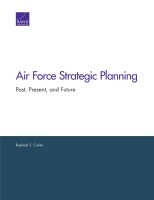| 来源类型 | Research Reports
|
| 规范类型 | 报告
|
| DOI | https://doi.org/10.7249/RR1765
|
| ISBN | 9780833096975
|
| 来源ID | RR-1765-AF
|
| Air Force Strategic Planning: Past, Present, and Future |
| Raphael S. Cohen
|
| 发表日期 | 2017
|
| 出版年 | 2017
|
| 页码 | 96
|
| 语种 | 英语
|
| 结论 |
There Currently Is Disagreement over the Utility of Long-Term Strategic Planning- Some senior leaders interviewed doubted their ability to predict and plan decades out in a concrete sense.
- Other senior leaders interviewed for this report worried that the Air Force's public documents have become too abstract and technology-focused, rather than concrete and strategic.
- Current and former planners tend to place a higher premium on strategic planning.
Historically, the Air Force Used Strategic Planning to Accomplish Four Key Tasks- Justify resources to U.S. Congress and to the rest of U.S. Department of Defense
- Structure the force and explain the structure to the rest of the service.
- Define and shape the service's mission and even identity particularly at strategic pivot points.
- Create a dialogue about the direction of the service within the service and with Congress and other key constituencies.
The Most Successful Air Force Strategies Have Applied Five Basic Lessons- Understanding the policy environment.
- Encouraging ideas from the bottom.
- Starting the strategy from the top.
- Keeping the message succinct, substantive, and sharp.
- Focusing on process as much as product.
|
| 摘要 |
- Encourage ideas from below: Cultivate free thinkers within the ranks and encourage dialogue between them and senior leaders.
- Know your environment: Tailor messages to specific audiences and understand the context — social, political, economic — of the period during which the document is produced and disseminated. Know that the messages that work inside the U.S. Department of Defense will not always play well when floated to a wide audience.
- Development strategy from the top: Strategy cannot simply be left to the planners and still be successful. For a strategy to produce real change, the Air Force strategy's priorities need to be its senior leader's priorities and those senior leaders need to be on the same page. Get leadership buy-in early in the process of developing the strategy.
- Keep the strategy succinct, substantive, and sharp: Successful strategy documents require a clear if blunt vision for the service defended by details and measured by a handful of select metrics about how the U.S. Air Force will fulfill its priorities, with few additional distractors.
- Focus on the process as much as the product: Air Force strategists perhaps should be more concerned about the discussions these documents spark, rather than necessarily what these documents say.
|
| 主题 | Aerospace
; Fighter Aircraft
; Military Doctrine
; Military Strategy
; United States Air Force
|
| URL | https://www.rand.org/pubs/research_reports/RR1765.html
|
| 来源智库 | RAND Corporation (United States)
|
| 引用统计 |
|
| 资源类型 | 智库出版物
|
| 条目标识符 | http://119.78.100.153/handle/2XGU8XDN/108490
|
推荐引用方式
GB/T 7714 |
Raphael S. Cohen. Air Force Strategic Planning: Past, Present, and Future. 2017.
|
|
文件名:
|
x1495316268170.jpg
|
|
格式:
|
JPEG
|

|
文件名:
|
RAND_RR1765.pdf
|
|
格式:
|
Adobe PDF
|
除非特别说明,本系统中所有内容都受版权保护,并保留所有权利。